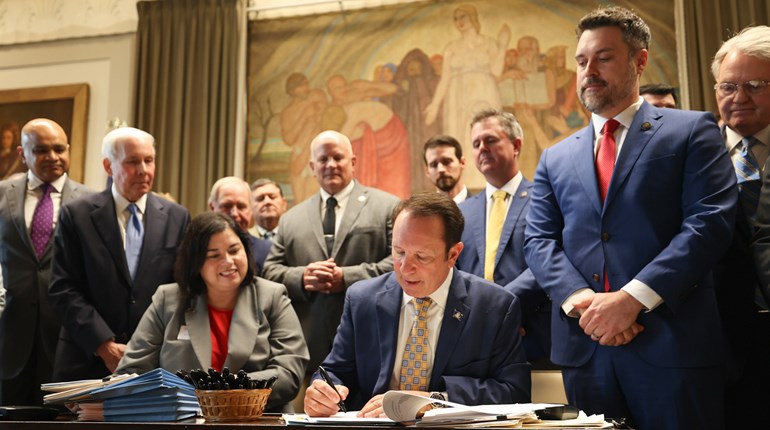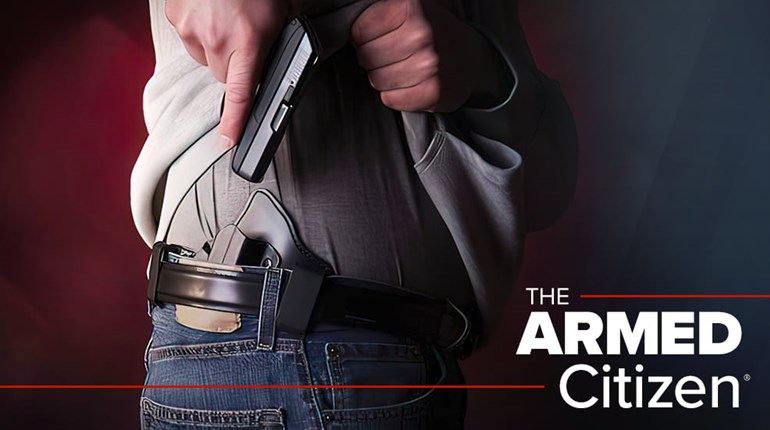
For me, it all started with my maternal grandfather, known to all in my family as “G-Dad.” More than anyone else, he introduced me to the world of shooting.
G-Dad had come up from some pretty mean streets in Birmingham, Ala. He used to describe carrying a slingshot (a real sling, what they called a “David sling,” not one of those Dennis the Menace rubber-band models), a knife and later a pistol that fired .22 shorts, all carried in order to navigate neighborhoods controlled by rival groups of teens.
He finished high school by the skin of his teeth and got a job working at a service station charging batteries and changing oil. He had the gift of gab par excellence, and over the years, he parlayed that first job into a senior executive position with the Pure Oil Company, which later merged into Union 76, but he never forgot where he came from. When he was a junior executive, he traveled through a lot of rural areas and always went armed, once fending off a late-night carjacking attempt.
My grandfather was an only child, and by the time I came along, he was happy to spend some time raising a boy. My parents were in graduate school and were happy for the peace, so I spent large chunks of every summer visiting. He would take me hunting, fishing and shooting. The “hunting” was mostly just shooting crows and the occasional squirrel or varmint. The fishing was for largemouth bass. The shooting was aiming at targets in the woods, or sometimes plinking and shooting rats at the county dump.
He had learned to shoot from his own grandfather, and the training was rough and ready by today’s standards, though he was strict on safety. But I was naturally a pretty good shot and took to it fairly well.
He also exposed me to the Second Amendment. He was a lifelong member of the National Rifle Association (in his honor, I became a Life Member many years ago) and he encouraged me to read American Rifleman. He even bought me a copy of Bruce and Esther Findlay’s guide for high schoolers, Your Rugged Constitution, which I devoured at a surprisingly early age. Is that why I became a law professor? Quite possibly.
While in junior high, and then while living in Maryville, Tenn., I took an NRA-sponsored firearms course at the teen center, where we learned about guns and got to shoot on an “indoor range” improvised in an underground parking lot. The instructors were a bunch of grizzled old World War II veterans … well, they seemed old to me, but they were probably in their fifties, for the most part; they taught old-fashioned riflery with a strong emphasis on using the sling for greater accuracy, and old-fashioned point-shooting with the pistol. They, too, talked about the Second Amendment a lot, with a degree of historical and legal acumen that might have surprised my classmates at Yale Law School, which I attended almost a decade later. There, I found the attitude toward guns was rather different. I remember once, when we were talking at lunch, one of my classmates turned to me and said, “you’ve actually fired a gun?” in much the same tones he might have used to say “you’ve actually eaten human flesh?” The Second Amendment wasn’t much discussed, but the general opinion was that it protected only the right of states to arm their national guards, or something like that, and whatever it did, it certainly didn’t guarantee any sort of a right for individual citizens to own guns.

There wasn’t much to base this on, really; a prewar U.S. Supreme Court opinion in United States v. Miller (1939) that was a lot narrower than people pretended, and a small amount of “scholarship” that included an article by Warren Burger in Parade magazine where he said that the idea of an individual right to own guns was a fraud perpetrated by the NRA. According to Burger, the Second Amendment protected “state armies,” not individuals. I was skeptical of this storyline, as that wasn’t how the Second Amendment looked to me, and the “state armies” angle made no sense. (To quote Tom Lehrer, “We’ll try to stay serene and calm / When Alabama gets the bomb.”)
It wasn’t long after law school—I was clerking for a federal Court of Appeals judge—when the first serious scholarly article on the Second Amendment appeared, Don Kates’ “Handgun Prohibition and the Original Meaning of the Second Amendment,” published in the Michigan Law Review. You can draw a straight line from Kates’ article to the Supreme Court’s opinions in Heller, McDonald and Bruen, but despite its thoroughness and deep scholarship, Kates’ piece didn’t make a big splash, even though it was published in a top law review and Kates had major credentials as a civil-rights lawyer who had worked with William Kunstler.
After a few years, famous constitutional scholar Sanford Levinson wondered aloud why there was no splash. In an article titled “The Embarrassing Second Amendment” in The Yale Law Journal, he suggested that the reason academics were ignoring the Second Amendment was because they supported gun control, and they feared that any serious attention to this part of the U.S. Constitution would call gun control into question. Levinson’s article was very important: Not only was he a top scholar publishing in a top journal, but he was well-known as a left-liberal scholar, so he couldn’t be dismissed as a shill for the NRA (though doubtless some would have liked to do so).
Levinson’s piece kind of opened the door for other scholarship. This sort of piece by a major figure made it safe for others to write about the subject and piqued the interest of law- review editors who otherwise would have written it off. In my own case, I was asked to write a short piece on the right to arms under the Tennessee Constitution for a symposium issue of the Tennessee Law Review, but that short piece became rather long. (The Tennessee Constitution is actually very interesting, and Tennessee courts had a lot to say about the right to arms.)
The next year, I was asked to write a short introduction to a Second Amendment symposium issue of the Tennessee Law Review, which became a rather lengthy piece setting out what I called the “Standard Model” of the Second Amendment, which described it as protecting an individual right to arms as a protection against government tyranny.
The symposium contained articles by numerous others, including Don Kates, Stephen Halbrook, Joyce Lee Malcolm and more. It is possibly the only law-review symposium—certainly one of only a few such—to be reviewed in The New York Review of Books. (Spoiler: They didn’t much like the individual-rights view of the Second Amendment. Their reviewer, Garry Wills, later wound up falling for the fraudulent Second Amendment research of disgraced historian Michael Bellesiles, who argued, improbably, that at the time the Constitution was framed, guns were rare and almost always owned by the government. After it turned out that a lot of his evidence had been made up, he was fired by Emory University.)
After that symposium came out, I found myself writing on the Second Amendment a lot—in law reviews, in newspapers and magazines, and in various briefs to the U.S. Supreme Court and to lower courts. And, over time, a lot of scholarship percolated into the courts from NRA challenges and briefs, and from others, that eventually resulted in the U.S. Supreme Court finding first that the Second Amendment protected an individual right to arms. Literally none of the justices, even among the dissenters, endorsed the “collective right” or National Guard theory that for decades had been the conventional wisdom among pundits and professors. In McDonald (2010), the high court found that the right applied against the states, and in Bruen (2022), that the right extended to the ability to carry guns outside the home.
The vast majority of states now have shall-issue carry laws, the number of states with “constitutional carry” requiring no permit at all is growing rapidly and far more Americans go legally armed than just a decade or two ago. Significantly, the anti-gunners’ decades-long strategy to “de-normalize” gun ownership has completely failed. This cultural shift is unequalled in recent history.
The NRA needs to be vigilant in its continued efforts to spread the knowledge of guns and shooting skills.
And I’d like to draw a couple of lessons from that. The first lesson is that, among conservatives and libertarians, there are a lot of people who like to play the “ain’t it awful” game, but they’re wrong. Like a chorus of Eeyores, they tell us that things are bad, that they’re getting worse, and that nothing we can do will change them. We’re doomed, doomed, doomed!
I don’t know why that particular species of political gloominess is so common among people who are otherwise sensible, but it is. It was true for decades, of course, that things for the gun-rights community were bad, and that things were getting worse. What wasn’t true was that we couldn’t do anything to change that. People worked to change it, and it changed. Things are now much better for the gun-rights movement than almost anyone would have dared to imagine 25 or 30 years ago.
The second lesson is the power of old men. I was a professor’s kid, and thus probably should have turned out as an anti-gun liberal. That I didn’t is because other people, mostly old men, cared. My grandfather cared, of course, and worked to help me understand both guns and the Constitution. And those World War II veterans who got up from their dinner tables after a day at work and went off to teach a bunch of teenagers about guns and shooting and the Second Amendment cared. And that made a difference, to me and to the other kids.
It’s tempting now to think that we’ve won in the Supreme Court and can relax. But no condition is permanent, especially when it depends on the votes of five justices. Culture is upstream of politics. You win a culture war by changing the culture. You keep a culture-war victory by defending and expanding that culture.
Despite all the victories, it’s still harder for a teenager to learn how to shoot and how to handle guns safely than it once was. Going forward, the NRA needs to be ever-vigilant in its continued efforts to spread the knowledge of guns, gun safety and shooting skills—plus knowledge of the Constitution—among young people and among adults who don’t have these skills.
It’s important to focus on elections, on lobbying, on ads and campaigns and media coverage, as those things are all important, but the day-to-day actions of people who care, in their own lives and among the people they live with, also make a huge difference. The NRA knows this; it is why the NRA has tens of thousands of certified firearms instructors working in communities across America anyone can find at NRAInstructors.org. The influence of such knowledgeable people certainly made a huge difference in my life, and I’m sure that I’m not the only one.
Glenn Harlan Reynolds is Beauchamp Brogan Distinguished Professor of Law at the University of Tennessee College of Law, and the author of numerous articles on the Second Amendment.


































